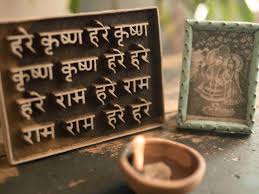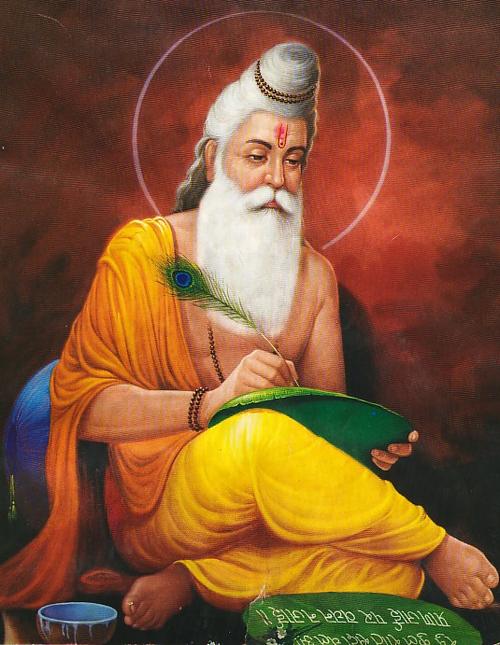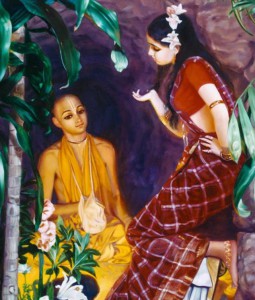The Story
One day, a group of sadhus (holy men) were passing by the home of Keshavacharya, a devout follower of Lord Krishna. The sadhus were weary and hungry from their journey, so Keshavacharya, out of his deep devotion and hospitality, invited them to take prasad (sanctified food). He lovingly prepared a delicious meal and offered it to his deity, Haridev. Just as he was about to serve the prasad to the sadhus, one of them noticed something and raised a concern.
“I just noticed that you do not have tapt-mudra!” exclaimed the sadhu. “Haven’t you taken initiation (diksha)?”
Keshavacharya calmly replied, “I am initiated, but I do not have tapt-mudra.”
According to the scriptures, tapt-mudra is one of the five essential rituals of Vaishnav initiation. It involves branding the symbols of the shankh (conch) and chakra (discus) on the shoulders of the devotee with a hot iron. These symbols mark one as a servant of Lord Narayan in Vaikuntha (the spiritual abode). However, the spiritual traditions of Vrindavan, where Keshavacharya resided, do not practice tapt-mudra. The devotees of Vrindavan are solely devoted to Radha and Krishna, and they do not see themselves as servants of Narayan in Vaikuntha, but as lovers of Krishna in Vrindavan.
The sadhus, unaware of this tradition, were shocked. “If you don’t have tapt-mudra, then you are not really initiated,” one sadhu declared. “And we cannot eat food cooked by an uninitiated man. We will go somewhere else to take prasad.”
The sadhus began to rise and leave, but Keshavacharya, with tears in his eyes, humbly pleaded with them to stay. He could not bear the thought of them leaving hungry.
“I may not have tapt-mudra,” Keshavacharya said earnestly, “But I am marked with the kripa (grace) of Harinaam.”
The sadhus, skeptical, demanded proof. “Prove it,” they said.
With humility, Keshavacharya removed his shawl. The sadhus were stunned to see that his entire body was covered with the Holy Name:
वृषभानु सुता श्रीनन्द सुवन
Vrishabhanu Suta-Shri Nand Suvan
Vrishabhanu Suta-Shri Nand Suvan
Vrishabhanu Suta-Shri Nand Suvan
This mantra, praising Srimati Radharani (Vrishabhanu Suta, the daughter of King Vrishabhanu) and Lord Krishna (Shri Nand Suvan, the son of Nanda Maharaj), had not been tattooed nor branded on Keshavacharya’s body. Instead, the Holy Name had manifested itself naturally on every inch of his skin, a divine sign of his deep, unwavering devotion.
Seeing this miraculous display, the sadhus were filled with awe and reverence. They offered their pranam (respectful obeisances) to Keshavacharya, recognizing him as a true saint. Humbled and blessed, they gladly accepted the prasad prepared by him, grateful for the opportunity to receive food from such a pure devotee.
Lessons to Be Learned
- True Initiation Comes from Devotion: The story teaches that the external symbols of initiation, like tapt-mudra, are secondary to the internal devotion and the grace of Harinaam. True initiation is marked by the transformation of the heart through sincere devotion.
- The Power of Harinaam: Keshavacharya’s body being marked with the Holy Name shows the immense power of chanting the Lord’s name with pure devotion. It emphasizes that the Holy Name itself is the highest form of initiation and protection.
- Humility and Compassion: Keshavacharya’s humility in pleading with the sadhus and his compassion in ensuring they did not go hungry demonstrate the qualities of a true devotee. Despite being misunderstood, he showed patience and love.
- Recognition of True Devotion: The sadhus’ recognition of Keshavacharya’s divine marks serves as a reminder that true spiritual stature is not always evident in external rituals but in the depth of one’s love and devotion to the Lord.
Prayer
O Lord,
Grant me the strength to hold Your Holy Name within my heart,
So that it may manifest in every aspect of my being.
Let my devotion be pure and unwavering,
Marked not by external symbols but by the grace of Your love.
May I always serve others with humility and compassion,
And recognize the true essence of devotion in every soul I meet.
Guide me on the path of pure bhakti,
So that I may always remain in Your loving presence.
Quote from Shastra
“nāma cintāmaṇiḥ kṛṣṇaś caitanya-rasa-vigrahaḥ,
pūrṇaḥ śuddho nitya-mukto ‘bhinnatvān nāma-nāminoḥ”
Translation:
“The Holy Name of Krishna is transcendentally blissful. It bestows all spiritual benedictions, for it is Krishna Himself, the reservoir of all pleasure. Krishna’s name is complete, and it is the form of all transcendental mellows. It is not a material name under any condition, and it is no less powerful than Krishna Himself.”
— Padma Purana
This verse underscores the idea that the Holy Name itself is complete and all-powerful, embodying Krishna’s divine presence, just as seen in the story of Keshavacharya.
4o



